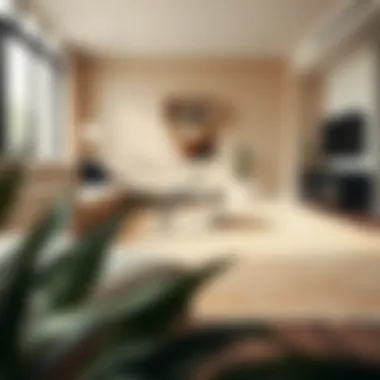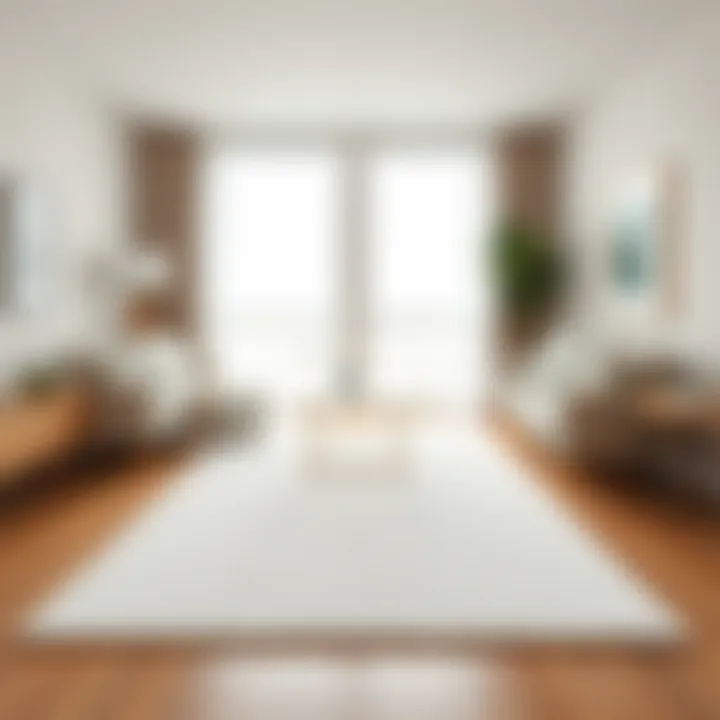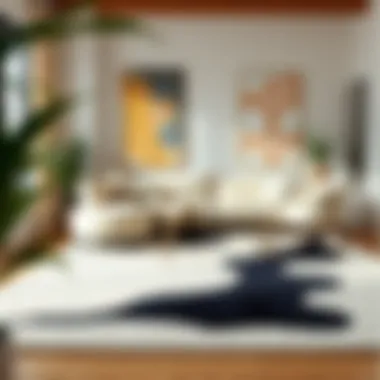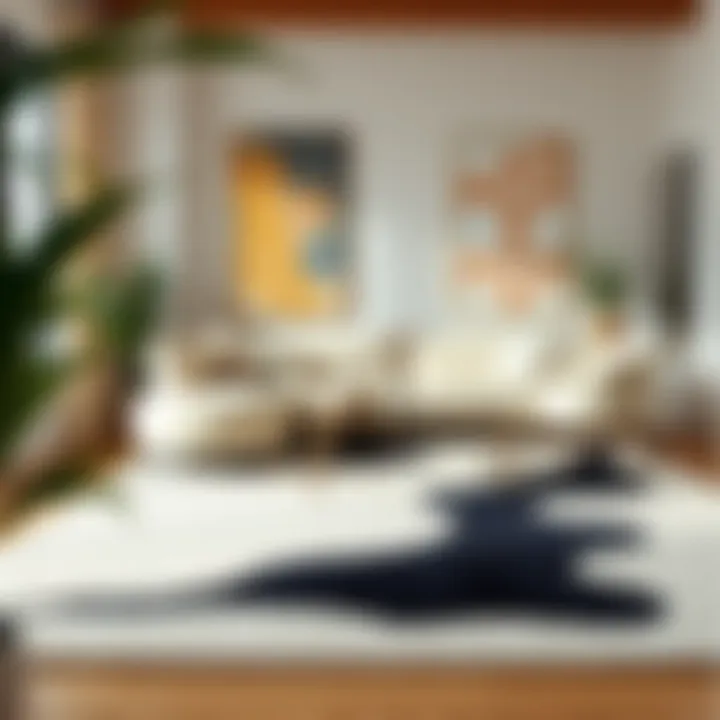The Allure of Beige, Black, and White Rugs in Modern Homes


Intro
In the realm of interior design, the colors that decorate a space can narrate stories, set moods, and create atmospheres. In today’s homes, the choices of flooring and textiles have evolved, giving rise to a fondness for the understated elegance of beige, black, and white rugs. These neutral tones seamlessly blend with various styles—be it contemporary, traditional, or eclectic—allowing them to elevate living spaces in unique ways.
Rugs serve not just a practical purpose but also an aesthetic one, anchoring the decor and providing comfort underfoot. In modern interiors, where bold hues and patterns constantly vie for attention, the subtle charm of earth tones like beige or the chic sophistication of black and white create a harmonious balance, complementing furniture and wall colors without overwhelming them.
As we explore further, this guide will shed light on the current furniture trends, including popular styles and materials, as well as key color palettes that define modern spaces. Additionally, we’ll provide practical design tips, touching on space optimization techniques and DIY projects for those eager to personalize their environments—all while keeping an eye on how these versatile rugs fit within the overarching design strategy.
Ultimately, understanding the role of beige, black, and white rugs in modern interiors transcends mere aesthetic value; it involves recognizing how texture and color interact to sculpt inviting, functional spaces. Whether you’re a homeowner looking to refresh your living area or a designer aiming to infuse new ideas, this guide promises insights that resonate with discerning tastes.
"Color is the keyboard, the eyes are the harmonies, the soul is the piano with many strings." - Wassily Kandinsky
As we journey ahead, let’s delve into the current furniture trends that shape the modern aesthetic.
Prelims to Color Dynamics
Understanding color dynamics is at the heart of effective interior design. Colors influence our surroundings, dictate the mood of a space, and even affect our emotions. This topic is crucial as it lays the groundwork for discussing how beige, black, and white rugs can transform modern interiors. Each color plays a distinct role; beige offers warmth and comfort, black provides depth and sophistication, while white introduces freshness and tranquility. Exploring these colors helps homeowners, designers, and DIY enthusiasts make educated decisions.
The Role of Color in Interior Design
Every space tells a story, and color is its language. In interior design, the right color combinations can bring harmony and balance or create a jarring effect. Designers often strive to evoke certain feelings through color. For instance, warm tones can make a room feel more inviting, while cooler tones can open up a space, making it feel larger. This is where our trusty trio—beige, black, and white—comes into play, as they fit into nearly every aesthetic and serve various purposes.
The role of color extends beyond mere aesthetics; it impacts behavior and comfort. For example, beige can create a sense of security, making it ideal for family spaces. Black adds an element of drama, perfect for accent pieces or focal points. Meanwhile, white can make spaces feel bright and airy, allowing for natural light to bounce off surfaces, enhancing visibility.
"Color is a power which directly influences the soul." - Wassily Kandinsky
Understanding Neutral Tones
Neutral tones are the unsung heroes in the world of interior design. They act as a backdrop, creating a foundation upon which other colors can shine. Beige, black, and white embody this neutrality, allowing them to seamlessly blend into any design scheme. This versatility makes them essential for achieving a balanced look.
- Beige: A warm neutral, beige brings a soft glow into a room. It pairs beautifully with both bright and dark accents, making it a favorite in modern design.
- Black: Often perceived as a bold choice, black serves as a powerful accent that can ground a space. It offers a striking contrast, especially against lighter colors.
- White: Universally celebrated for its brightness, white amplifies light within a room. It can simplify a space, creating a clean and modern feel.
Utilizing these neutral tones can effectively unify various design elements. For homeowners and designers alike, recognizing the importance of color dynamics facilitates more thoughtful selections in fabric, furniture, and, notably, rugs. Incorporating the right color can elevate the overall aesthetic and mood of the space.
Beige, Black, and White: A Timeless Trio
In the realm of interior design, color choices can significantly affect the overall feel of a space. Beige, black, and white represent a versatile palette that strikes a balance between warmth, elegance, and simplicity. Each hue in this trio offers unique characteristics, making them indispensable in modern home décor.
The Aesthetic Value of Beige
Beige often provides a soft canvas that subtly complements other colors in a room. This neutral shade exudes warmth and approachability, making it perfect for living spaces where comfort is key. It’s also a shade that’s neither too bold nor too bland, striking the right chord for homeowners looking for understated elegance.
When choosing carpets in beige, one might consider a variety of textures such as plush or flatweave to achieve the desired ambiance. This color tends to reflect light beautifully, creating an inviting environment. Additionally, beige works exceptionally well with various styles—from contemporary to rustic—allowing for an adaptable foundation that can evolve with trends over time.
The Boldness of Black in Design
Black is a color that can easily command attention. Many might consider it a daring choice for rugs, as it creates a stark contrast in brighter spaces. However, when used judiciously, black can anchor a room and add an element of sophistication. It serves as a dramatic backdrop, highlighting lighter furnishings and art pieces, all while enhancing depth.
Furthermore, black rugs can be quite practical; they tend to conceal stains and dirt better than their lighter counterparts. When considering designs, patterns featuring black can add intriguing visual interest, keeping a space lively yet cohesive. The key is to balance black's intensity with other tones in the room for an overall harmonized look.
The Purity of White as a Base
White rugs embody purity and simplicity, effortlessly amplifying any interior design scheme. By serving as a blank slate, they allow homeowners to express creativity through accent colors and furniture. White reflects light, contributing to a sense of spaciousness, making it an excellent choice for smaller rooms or those devoid of natural light.
In terms of maintenance, while they may require regular cleaning, white rugs can dramatically elevate the sophistication of a room when properly cared for. They evoke calmness, ideal for serene spaces like bedrooms or meditation corners. Mixing white with light woods or vibrant colors can create a fresh, airy aesthetic that appeals to many.
Ultimately, beige, black, and white collectively serve as a timeless trio in modern interiors. Their inherent flexibility caters to a wide range of tastes and styles, whether for a chic urban apartment or a cozy suburban home.
"Color is a power which directly influences the soul."
– Wassily Kandinsky
Integrating these hues into your designs doesn’t just enhance aesthetic appeal but can also foster emotional resonance within a space. With careful consideration of each shade's function and impact, homeowners can achieve sophisticated interiors that remain stylish across seasons.
Design Compatibility
Design compatibility plays a significant role in making choices for interior spaces. It determines how well different elements harmonize with each other, contributing to an overall aesthetic that feels intentional and cohesive. When it comes to rugs, especially in beige, black, and white, this compatibility can enhance or detract from the desired atmosphere of a room. Selecting the right rug involves considering factors such as color coordination, style consistency, and scale relative to furniture and space.


Modern Minimalism
In the realm of modern minimalism, simplicity reigns supreme. Here, beige, black, and white rugs shine as they complement the stripped-down aesthetic of this design approach.
- Visual Clarity: Minimalist decor typically favors a clean look. A beige rug can serve as a warm backdrop, while black adds striking contrasts, and white can create the illusion of expansiveness.
- Functional Appeal: In this style, every element should possess a functional purpose. Rugs made from low-pile materials are particularly suited for minimal design because they keep the floor's clean lines intact without overwhelming the eye.
- Color Cohesion: The palette of beige, black, and white aligns beautifully with minimalist principles, offering a combination that is sophisticated yet understated.
In essence, these rugs can anchor a minimalist room, bringing together various elements without creating visual clutter.
Mid-Century Modern Fusion
Mid-century modern design draws from the past while embracing clean lines and organic forms. The rugs in this category can be pivotal in establishing that bridge between different materials and colors present in mid-century decor.
- Eclectic Versatility: Rugs in beige can harmonize with wooden furniture, while bold black patterns can introduce a dynamic energy to more subdued decor. White rugs can make bold colors pop, providing a backdrop for vibrant accents.
- Texture Variety: The mid-century style often incorporates a mix of materials. Choosing a textured rug can enhance the tactile experience of a room, balancing sleek furniture with something comforting underfoot.
- Visual Interest: Geometric patterns prevalent in mid-century can be beautifully complemented with the classic tones. Using a rug that blends these colors and patterns can create focal points without overwhelming the space.
Overall, the compatibility of these colors and styles allows homeowners to blend their love for the past with contemporary twists.
Traditional and Vintage Styles
Despite the modern uses of beige, black, and white rugs, they can also find their place in traditional and vintage-themed interiors. Their versatility means they can either blend seamlessly or stand as striking contrasts within these aesthetics.
- Subtle Elegance: Beige achieves a soft, subtle warmth that can accentuate traditional wood furnishings or vintage decor. This makes it an ideal choice for a layered, textured look.
- Classic Color Pairing: Black can assert a sense of formality, particularly when paired with traditional patterns, and can also serve to ground the space.
- Timeless Appeal: White adds an air of freshness and can make ornate vintage pieces stand out, allowing intricate details to shine through the simplicity of the color.
To conclude, rugs in these classic colors offer a palette that respects tradition while introducing a modern sensibility. Each style has its own nuances of compatibility, shaping environments that resonate with authenticity and thoughtful design.
"Choosing a rug isn’t just about aesthetics; it’s about creating an entire atmosphere in a space. The right colors and patterns can define the feel of your home."
Choosing the Right Material
Choosing the right material for your beige, black, and white rugs profoundly influences not just the look but the experience of your living spaces. The material can affect everything from durability to ease of cleaning and even the tactile sensation when one walks across the rug. While aesthetics often take front and center, it's essential not to overlook these practical components that form the backbone of a well-designed interior.
Opting for the correct rug material can lead to numerous benefits, enhancing both longevity and comfort. Homeowners, designers, and DIY enthusiasts ought to approach material selection with an understanding of how various fibers respond to factors like foot traffic, moisture, and decorative themes. This knowledge can transform a mere rug from being a floor cover to an integral part of your home’s personality.
Wool Versus Synthetic Fibers
When it comes to rugs, both wool and synthetic fibers frequently emerge as primary options. Wool has been a favored choice for centuries, celebrated for its natural luster and durability. Not only does wool add warmth to a space, but it also possesses inherent stain resistance and can absorb moisture better than many synthetic alternatives. This can make wool rugs particularly suitable for areas with fluctuating humidity levels.
On the other hand, synthetic fibers, like nylon or polyester, offer some advantages as well. They are typically more affordable and come with the perk of being stain-resistant and easier to clean. Homeowners looking for vibrant colors or intricate patterns may find synthetic rugs more appealing, as they can be produced in a wide array of designs without breaking the bank.
However, while wool enhances your interior with a touch of luxury, synthetic materials may sometimes give a more flexible but less elegant appearance. Ultimately, the choice of wool or synthetic fibers boils down to personal preference and lifestyle.
Cost, aesthetic preference, and maintenance should all weigh into your decision.
Texture and Durability Considerations
The texture of a rug does more than just please the touch; it also shapes the ambiance of a space and its perceived coziness. The feel of a rug underfoot can provide comfort on a chilly morning or create a tactile interest that draws people into your home. For instance, a plush, shaggy black rug may conjure feelings of comfort and luxury, whereas a flatweave beige rug can offer a more minimalist vibe that fits seamlessly in modern interiors.
In terms of durability, each material type has its quirks. Wool is naturally resilient, springing back to its original shape after being compressed, which is ideal for high-traffic areas such as living rooms. Synthetic alternatives are often designed to withstand wear and tear, making them a solid option for budget-conscious households or settings with children and pets.
Here’s a quick rundown of factors to evaluate:
- Traffic Level: Consider where the rug will go. High-traffic zones may benefit from more resilient synthetic materials, while low-traffic areas could embrace the softness of wool.
- Comfort vs. Functionality: A totally soft rug may not always work well under furniture or in busy areas. Balance comfort with functionality for the best results.
- Cleaning Needs: Lightweight synthetics might be easier for those who prefer a no-fuss cleaning routine, while wool can require more committed care but rewards with enduring beauty.
"A rug is like a piece of art; its material, texture, and placement can tell a story about your space."
For more about the care and specifics of different rug fibers, check out resources from reputable sites like Encyclopedia Britannica, and Educational Institutions.
Impact on Space Aesthetics
In the realm of interior design, aesthetics holds significant sway over how a space is perceived and experienced. When it comes to rugs, especially those in beige, black, and white, the selection transcends mere functionality, embedding itself deep within the fabric of your decor. These hues have the remarkable ability to transform rooms, complement existing furnishings, and evoke distinct moods. Understanding the implications of these colors is key for homeowners and designers looking to curate a cohesive living atmosphere.
Creating Visual Balance
Achieving visual balance is often a dance of proportions, colors, and textures. A beige, black, or white rug can serve as a neutral anchor amidst vibrant furniture or bold decor elements. For instance, when placed under a sturdy black sofa, a light beige rug can soften contrasts, while simultaneously enhancing warmth. It’s like adding a splash of cream to your coffee—transforming the bitter to the pleasant.
Here are a few strategies to consider:


- Layering Textures: Combine a plush white shag rug with sleek leather furniture to deliver a tactile contrast, inviting guests to appreciate both comfort and sophistication.
- Size Matters: Oversized rugs can create a grounding effect in larger spaces, while smaller mats can delineate areas within open floor plans.
- Combine with Decorative Elements: Pair your rugs with harmonious wall colors or artwork to create a continuous thread throughout the room. A black and white rug can echo the shades in a framed monochrome photograph mounted nearby.
"The right rug is more than a decorative piece; it’s a visual anchor that can either pull together a room or make it feel disjointed."
Enhancing Lighting and Ambiance
Light interacts with color. When it comes to beige, black, and white rugs, they play a pivotal role in shaping how light bounces around your room. A white rug, in particular, reflects light, making spaces feel more expansive and airy. This is especially beneficial in smaller rooms where you aim to create an illusion of space.
Conversely, black rugs can absorb light while adding depth. In an environment with ample natural light, it can create a chic, contemporary vibe. The key is to leverage these characteristics strategically:
- Natural Light: In well-lit areas, a white or light beige rug can amplify sunshine, resulting in a more inviting atmosphere.
- Mood Lighting: A black rug can serve as a backdrop for accent lighting, highlighting art pieces or table settings beautifully.
- Ceiling Height: In rooms with lofty ceilings, a beige rug can help draw the eye downward, creating a cozy intimacy that might otherwise feel lost in a large space.
Rug Placement Strategies
Rug placement is a significant aspect in the use of beige, black, and white rugs within modern interiors. This strategy often determines how a space is perceived and functions. An apt placement can not only enhance the aesthetics but also create comfort and flow throughout a room. It's important to consider the unique elements of a room, the existing decor, and the practical use of space when deciding on rug placement. Getting it right can lead to a more cohesive design, while improper positioning can disrupt a space's rhythm and appeal.
Living Room Layouts
Defining Seating Areas
Defining seating areas with rugs is a particularly effective way to establish zones within an open-plan living space. By positioning a rug beneath furniture, you signal where social interactions happen. This arrangement not only enhances comfort but also creates a visual boundary that frames the area nicely. The key characteristic of this tactic lies in its ability to make a room feel more intimate, no matter its size. Homeowners often gravitate towards this method as it encourages gatherings and conversation.
One unique feature is the way it can visually anchor larger pieces of furniture. A well-placed rug can transform a chaotic-looking living room into a well-defined space. However, it does have some drawbacks; for instance, selecting the wrong size can make the seating arrangement feel cramped or too disjointed.
Creating Flow
Creating flow through rug placement is about contributing to the overall movement within a space. This method emphasizes a seamless transition from one area to another, particularly in open-concept homes. The essential characteristic of this approach is its simplicity. By choosing rugs that complement each other in color or pattern, homeowners can unify various areas, making it feel like a single, cohesive design.
A distinct advantage of this strategy is that it helps guide the eye through a room. Visitors naturally know where to walk, which aids in navigation and functionality. However, there’s a potential downside; too many variations in rugs or patterns can feel overwhelming, leading to visual confusion.
Bedroom Considerations
Placement at Bedside
Placement at bedside is another strategy deserving recognition. Employing a rug next to the bed not only emphasizes the sleeping area but also adds warmth and comfort right where you need it upon waking. The central idea here is to provide a soft landing for feet getting out of bed. The key aspect making this choice so popular is the cozy feeling it imparts, which is vital for a restful environment.
This layout option is beneficial as it creates a nice focal point in the bedroom, while the material chosen can also elevate the comfort level. Risks include selecting a rug that doesn’t match the overall decor or choosing one that’s too small, which may disrupt the intended balance.
Layering Techniques
Layering techniques in rug placements allow homeowners to play with textures and patterns. This approach involves placing a smaller rug over a larger one, creating depth and interest. It can enhance various design elements within a room by introducing contrast or tying together differing color schemes. The key characteristic of this method is its flexibility; it’s a way to showcase creativity without a complete overhaul of the space.
A single unique feature is the ability to adjust the appearance of rugs depending on season or mood. This adaptability attracts many homeowners, allowing them to keep their space looking fresh and dynamic. However, challenges do arise; if not executed well, layered rugs can lead to cluttered visuals, making a room feel busy rather than harmonious.
Effective rug placement can dramatically alter the perception of space, making rooms feel more inviting and intentional.
Maintenance and Care
When it comes to the longevity of your beige, black, and white rugs, understanding maintenance and care is essential. These rugs not only add beauty to your space but can also capture dirt, stains, and wear over time. A good maintenance routine ensures that these pieces remain eye-catching and retain their integrity. With homes busier than ever, having a practical plan can make all the difference.
Investing time in proper care can enhance the aesthetic appeal and significantly extend the lifespan of your rugs. This section breaks down the essentials of cleaning techniques tailored to different materials and preventative measures that keep your rugs looking fresh for years.
Cleaning Techniques for Various Materials
Different rug materials require specific cleaning techniques to avoid damage. Here's a closer look at how to handle various fabrics effectively:
- Wool Rugs: These are sturdy and can withstand some scrubbing. However, it's best to use a gentle, pH-neutral detergent mixed with water. Blot stains right away. Avoid soaking the fabric. Instead, lightly dampen a cloth with the solution and blot (don't rub).
- Synthetic Fibers: Rugs made from nylon or polyester are less delicate than wool but still need care. A mixture of vinegar and water can be effective for spot cleaning. These materials are usually machine washable, so refer to the manufacturer's instructions.
- Natural Fibers: For rugs made of jute or sisal, it's crucial to not use water directly, as it can lead to mildew or mold. Instead, use a vacuum cleaner and dry clean them periodically to eliminate dirt without introducing moisture.
- Cotton Rugs: Typically washable, cotton rugs benefit from a trip through the washing machine. Use mild detergent and air dry to avoid shrinkage. Make sure to read any labels regarding machine washability.
"Regular care prevents dirt buildup and keeps the rugs looking their best, ensuring they are always a stunning focal point in your space."
Preventative Measures
Preventative care is just as important as cleaning techniques. By implementing a few strategies, you can keep your beige, black, and white rugs in top shape:
- Regular Vacuuming: Dust and debris can damage the fibers over time. Vacuuming at least once a week helps remove dirt before it settles in.
- Use a Rug Pad: This not only provides cushioning and prevents slipping but also helps absorb some of the impact and wear.
- Rotate Your Rugs: To ensure even wear, consider rotating your rug every few months. This is particularly important in high-traffic areas, where one side might bear more weight than the other.
- Address Spills Promptly: Accidents happen, but it's crucial to tackle spills as soon as they occur. Blot (don't rub!) the area with a clean cloth and use appropriate cleaning products as necessary.
- Limit Direct Sunlight: Direct exposure to sunlight can fade colors over time. Use curtains or blinds to protect your rugs and maintain their vibrancy.


By understanding the needs of your rugs and integrating these maintenance strategies, you ensure they not only last longer but also continue to enhance the beauty of your living space.
Color Psychology and Mood Enhancement
Color psychology plays a pivotal role in interior design, connecting the hues we surround ourselves with to our feelings and behaviors. Understanding how colors like beige, black, and white influence mood and ambiance can significantly enhance the living experience. These colors not only create a backdrop for our spaces but also serve as tools to evoke certain emotions and reactions. Exploring these effects can help homeowners, designers, and anyone interested in creating a harmonious environment to make informed choices.
The Psychological Effects of Beige
Beige is often regarded as a warm, inviting shade. It has a unique ability to create a cozy atmosphere without overwhelming the senses. This softly spoken tone draws on the beauty of nature, resembling sandy shores or winter wheat fields. As a neutral, it provides a versatile canvas that can adapt to various design styles. Incorporating beige rugs into a space often promotes feelings of comfort and security.
When used in larger areas, beige can also serve to harmonize contrasting colors, making stronger hues feel more grounded. No wonder many designers suggest its use in spaces intended for relaxation, like living rooms or bedrooms. It’s not just a color; it’s an invitation to unwind.
Black's Influence on Mood and Space
Black carries boldness and sophistication, allowing it to command attention in a design scheme. Though some might think black makes spaces feel smaller, it can also create a stunning sense of depth. When strategically placed, such as in a rug, black can linger in the background while drawing the eye to furniture and artwork. This powerful color fosters an air of elegance and can elevate a space from mundane to extraordinary.
The psychological influence of black is fascinating. It can convey authority and strength, yet when mixed with softer elements, it offers a balance that feels dynamic instead of oppressive. For spaces that require focus, like home offices, a black rug can provide a grounding effect, allowing creativity to flourish amidst the calm.
White's Role in Creating Calmness
White is synonymous with purity, clarity, and peace. It's often associated with fresh starts and clean slates—ideal for spaces where tranquility is crucial. The presence of white can help reflect light, making smaller rooms feel more expansive and airy. When it comes to incorporating white rugs, they can transform areas into serene retreats. This color invites a breath of fresh air, perfect for spaces designed to inspire relaxation or contemplation.
However, too much white can sometimes feel sterile, so it's essential to inject some warmth through textures or accessories. This balance allows white to serve as both a backdrop and a calming influence. When combined with beige or black, the triadic harmony can result in profound emotional effects across a room, effectively enhancing its overall aesthetic while promoting a peaceful ambiance.
"Colors have a type of energy that can significantly impact our environments. It's essential to choose them wisely to uplift the mood of any space."
For additional insights into color psychology, you might find useful resources like Wikipedia's Color Psychology or Britannica's take on Color. All these elements intertwined can lead to a compelling design that resonates well with its occupants.
Trends in Rug Design
The landscape of modern interior design is constantly shifting, influenced by various factors including cultural nuances, technological advancements, and ecological consciousness. Understanding trends in rug design is paramount for homeowners and professionals alike who seek not just to decorate spaces but to create atmospheres that resonate with contemporary sensibilities. Beige, black, and white rugs serve as a versatile foundation in these discussions, standing at the crossroads of aesthetics and functionality.
Firstly, today’s consumers are increasingly discerning, looking for designs that marry beauty with practicality. Beige, black, and white rugs fit this narrative, easily blending with myriad decor styles while offering durability and maintained appeal. The diverse versatility of these color palettes makes them indispensable in modern settings. Homeowners can enhance their spaces to evoke warmth, elegance, and sophistication without overwhelming their aesthetic.
Emerging Patterns and Textures
One of the most exciting aspects of rug design is the emergence of innovative patterns and textures. While solid rugs in neutral tones have their place, layers of texture can add depth to any environment. Ropes, fringes, and geometric shapes in beige, black or white often steal the spotlight and create an inviting juxtaposition with sleek furniture.
- Geometric Patterns: These can lend a sense of modernity to spaces, often found in black and white combinations. Designs that play with shapes create visual excitement without being gaudy.
- Textural Combinations: Consider a plush white shag rug paired with a flatweave black mat. This contrast can make for striking visuals and an intriguing tactile journey.
This trend extends beyond visuals; it speaks to a lifestyle where comfort is key. As many seek a living space that feels inviting, these patterns and textures play a crucial role.
Sustainability in Rug Manufacturing
With the rising concern over environmental issues, sustainability has become a defining trend within rug design. Consumers are now scrutinizing where and how their furnishings are made. Brands that support eco-friendly practices often see a boost in consumer confidence.
- Utilize natural fibers, like wool or jute, that not only reduce the environmental footprint but also provide better durability.
- Innovations in dye processes aim at minimizing water usage and chemical inputs. This is particularly relevant in the production of rugs that use black and white shades.
"Opting for sustainable rugs reflects a commitment not just to personal style, but to a broader responsibility toward the environment."
Going for sustainable options in beige, black, and white rugs can foster a contemporary aesthetic while ensuring ecological considerations are in play. Understanding these trends is vital for anyone involved in home decor or design, allowing them to align with consumer expectations while showcasing their style proficiency.
By navigating through trends in rug design, individuals can meaningfully connect with spaces. With the chic nature of beige, black, and white rugs, the possibilities become endless, affording not only beauty but purpose.
Final Thoughts
The discussion surrounding beige, black, and white rugs serves as a vital component of contemporary interior design that should not be overlooked. These timeless colors work harmoniously together, creating a foundation for various styles and moods within a room. Their versatility allows them to transcend trends and seasons, ensuring that users can achieve a seamless blend no matter how tastes may evolve over time.
Summary of Key Points
In summary, the article has traversed the essential roles of beige, black, and white rugs, touching on aspects that echo through all realms of design:
- Color Dynamics: These hues function as neutral backdrops that support a range of interior palettes while setting a sophisticated tone.
- Design Compatibility: Whether one opts for a minimalist look or embraces a rich nostalgia of vintage aesthetics, these colors fit right in. They can define spaces, enhance decor continuity, and unify disparate elements.
- Material Considerations: Choosing between wool and synthetic fibers equips homeowners with options based on desired durability and maintenance level.
- Psychological Effects: Each color brings its unique energy into a space, influencing moods and perceptions of comfort and calmness.
- Maintenance in Practice: Proper care strategies ensure these rugs maintain their appeal and practicality, reflecting a homeowner's commitment to their environment.
The Future of Rugs in Interior Design
Looking ahead, the future of rugs—particularly those in neutral colors—promises to be one of innovation blended with a reverence for timeless design principles. As sustainability becomes an increasing concern, manufacturers are adopting eco-friendly materials while maintaining the aesthetic qualities demanded by the discerning homeowner.
Demand for customization is also on the rise. People are interested in unique textures and patterns that can infuse personality into these traditionally simple color schemes. Technology is enabling designers to create dynamic patterns digitally, allowing homeowners to incorporate their preferences while retaining versatility.
Overall, while beige, black, and white rugs may seem straightforward, they open the door to profound stylistic possibilities. Fostering a perfect blend of modernity with the stark elegance of monochrome color, the journey of these rugs into the future reveals a colorful transition that begins with a simple foundation.



